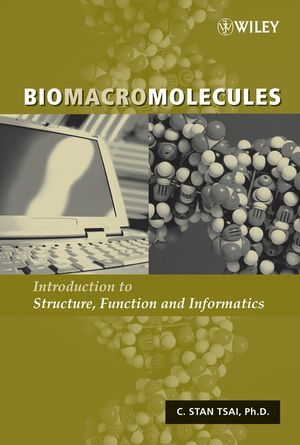Biomacromolecules: Introduction to Structure, Function and InformaticsISBN: 978-0-471-71397-5
Hardcover
768 pages
November 2006
 |
||||||
Abbreviations in Repetitive Use.
CHAPTER 1. INTRODUCTION.
1.1 Prelude.
1.2 Covalent Bonds.
1.3 Noncovalent Interactions.
1.4 Isomerism: Configuration versus Conformation.
1.5 Trilogy.
1.6 References.
CHAPTER 2. MONOMER CONSTITUENTS OF BIOMACROMOLECULES.
2.1 Nucleotides: Constituents of Nucleic Acids.
2.2 á-Amino Acids: Constituents of Proteins.
2.3 Monosaccharides: Constituents of Glycans.
2.4 Addendum.
2.5 References.
CHAPTER 3. PURIFICATION AND CHARACTERIZATION.
3.1 Purification: Overview.
3.2 Purification: Chromatography.
3.3 Purification: Electrophoresis.
3.4 Characterization: General.
3.6 References.
CHAPTER 4. BIOMACROMOLECULAR STRUCTURE: NUCLEIC ACIDS.
4.1 Structural Organization.
4.2 Sequence Analysis of Nucleic Acids.
4.3 Secondary Structure and Structure Polymorphism of DNA.
4.4 Supercoiling and Tertiary Structure of DNA.
4.5 Classification and Structures of RNA.
4.6 RNA Folds and Structure Motifs.
4.7 Energetics of Nucleic Acid Structure.
4.8 Nucleic Acid Application.
4.9 References.
CHAPTER 5. BIOMACROMOLECULAR STRUCTURE: PROTEINS.
5.1 Architecture of Protein Molecules.
5.2 Primary Structure of Proteins: Chemical and Enzymatic Sequence Analysis.
5.3 Primary Structure of Proteins: Sequence Analysis by Tandem Mass Spectrometry.
5.4 Conformational Map.
5.5 Secondary Structures and Motifs of Proteins.
5.6 Domains and Tertiary Structures of Proteins.
5.7 Classification of Protein Structures.
5.8 Quaternary (Subunit) Structures of Proteins.
5.9 Quinternary Structure Exemplified: Nucleoproteins.
5.10 Conformational Energetics.
5.11 References.
CHAPTER 6. BIOMACROMOLECULAR STRUCTURE: POLYSACCHARIDES.
6.1 Propagation of Polysaccharide Chains.
6.2 Sequence Analysis of Polysaccharides: Primary Structure.
6.3 Conformation: Secondary and Tertiary Structures of Polysaccharide Chains.
6.4 Conformation: Description of Some Polysaccharide Structures.
6.5 Glycobiology: Study of Glycoprotein- Associated Glycans.
6.6 Neoglycoproteins.
6.7 Organizational Levels of Biomacromolecular Structures.
6.8 References.
CHAPTER 7. STUDIES OF BIOMACROMOLECULAR STRUCTURES: SPECTROSCOPIC ANALYSIS OF CONFORMATION.
7.1 Biochemical Spectroscopy: Overview.
7.2 Ultraviolet and Visible Absorption Spectroscopy.
7.3 Fluorescence Spectroscopy.
7.4 Infrared Spectroscopy.
7.5 Nuclear Magnetic Resonance Spectroscopy.
7.6 Optical Rotatory Dispersion and Circular Dichroism Spectroscopy.
7.7 X-ray Diffraction Spectroscopy.
7.8 References.
CHAPTER 8. STUDIES OF BIOMACROMOLECULAR STRUCTURES: CHEMICAL SYNTHESIS.
8.1 Rationale.
8.2 Synthetic Strategy: Conventional Approach.
8.3 Synthetic Strategy: Solid Phase Approach.
8.4 Practice of Solid Phase Synthesis and Its Application.
8.5 Combinatorial Synthesis.
8.6 Biochemical Polypeptide Chain Ligation.
8.7 References.
CHAPTER 9. STUDIES OF BIOMACROMOLECULAR STRUCTURES: COMPUTATION AND MODELING.
9.1 Potential Energy and Molecular Thermodynamics.
9.2 Molecular Modeling: Molecular Mechanical Approach.
9.3 Statistical Thermodynamics.
9.4 Structural Transition: Examples.
9.5 Structure Prediction from Sequence by Statistical Methods.
9.6 Molecular Docking: Prediction of Biomacromolecular Binding.
9.7 References.
CHAPTER 10. BIOMACROMOLECULAR INTERACTION.
10.1 Biomacromolecules in Solution.
10.2 Multiple Equilibria.
10.3 Allosterism and Cooperativity.
10.4 Specificity and Diversity of Antibody- Antigen Interactions.
10.5 Complementarity in Nucleic Acid Interactions.
10.6 Molecular Recognition in Carbohydrate- Lectin Interaction.
10.7 References.
CHAPTER 11. BIOMACROMOLECULAR CATALYSIS.
11.1 Biocatalyst: Definition and Classification.
11.2 Characteristics of Enzymes.
11.3 Enzyme Kinetics.
11.4 Enzyme Mechanisms.
11.5 Enzyme Regulation.
11.6 Abzyme.
11.7 Ribozyme.
11.8 References.
CHAPTER 12. SIGNAL TRANSDUCTION AND BIODEGRADATION.
12.1 Chemical Transduction: Metabolism.
12.2 Elements of Signal Transduction.
12.3 Effector Enzymes and Signal Transduction.
12.4 Topics on Signal Transduction.
12.5 Apoptosis.
12.6 Hydrolysis versus Phosphorolysis of Glycans.
12.7 Nucleolysis of Nucleic Acids.
12.8 Proteolysis and Protein Degradation.
12.9 References.
CHAPTER 13. BIOSYNTHESIS AND GENETIC TRANSMISSION.
13.1 Saccharide Biosynthesis and Glycobiology.
13.2 Genetic Information and Transmission.
13.3 DNA Replication and Repair.
13.4 Biosynthesis and Transcription of RNA.
13.5 Translation and Protein Biosynthesis.
13.6 Folding of Biomacromolecules.
13.7 Bioengineering of Biomacromolecules.
13.8 References.
CHAPTER 14. BIOMACROMOLECULAR INFORMATICS.
14.1 Overview.
14.2 Biosequences.
14.3 Microarray: General Description.
14.4 Computer Technology.
14.5 Informatics.
14.6 Gene Ontology.
14.7 References.
CHAPTER 15. GENOMICS.
15.1 Genome: Features and Organization.
15.2 Genome Informatics: Databases and Web Servers.
15.3 Approaches to Gene Identification.
15.4 Gene Expression.
15.5 Genome Project.
15.6 References.
CHAPTER 16. PROTEOMICS.
16.1 Proteome: Features and Properties.
16.2 Proteome Informatics: Sequence Databases and Servers.
16.3 Proteome Informatics: Structure Databases and Servers.
16.4 Proteome Informatics: Proteomic Servers.
16.5 Protein Structure Analysis Using Bioinformatics.
16.6 Investigation of Proteome Expression and Function.
16.7 Metabolome.
16.8 References.
CHAPTER 17. GLYCOMICS.
17.1 Features of Glycomics.
17.2 Glycomic Databases and Servers.
17.3 Glycomics: Genetic Approaches.
17.4 Glycomics: Proteoglycomic Approaches.
17.5 Glycomics: Chemoglycomic Approaches.
17.6 References.
CHAPTER 18. BIOMACROMOLECULAR EVOLUTION.
18.1 Variation in Biomacromolecular Sequences.
18.2 Element of Molecular Phylogeny.
18.3 Phylogenetic Analysis of Biosequences.
18.4 Application of Sequence Analyses in Phylogenetic Inference.
18.5 Evolution of Biosequences.
18.6 Evolution of Protein Structure and Function.
18.7 References.
INDEX.



